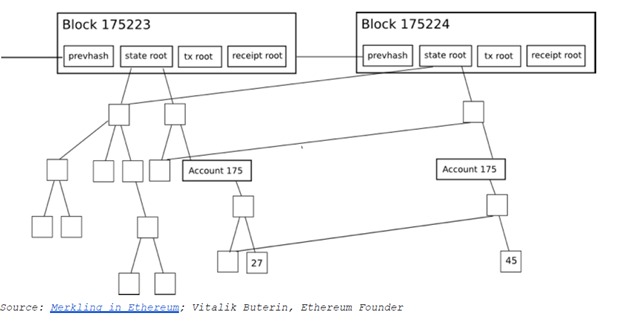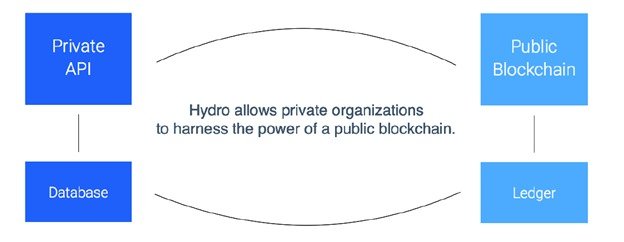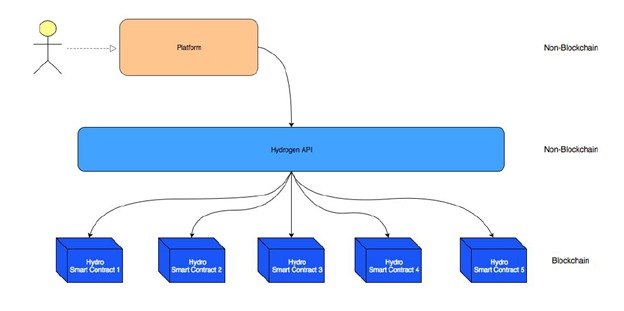INTRODUCTION
HYDRO: Etymology - From Ancient Greek ὑδρο- ( hudro- ), from ὕδωρ( húdōr , “water”)
Hydro enables new and existing private systems to seamlessly integrate and leverage the immutable & transparent dynamics of a public blockchain to enhance application and document security, identity management, transactions, and artificial intelligence.
In this paper, a case will be made for private systems, such as APIs, to use the Hydro public blockchain to enhance security through public authentication.
The proposed technology is called “Raindrop” - a transaction performed through a smart contract that validates private system access publicly, and can complement existing private authentication methods. The technology is intended to provide additional security for sensitive financial data that is increasingly at risk from hacking and breaches.
Initial implementation of the Hydro Raindrop is performed on the Hydrogen API Platform. This modular set of APIs is available to enterprises and developers globally to prototype, build, test, and deploy sophisticated financial technology platforms and products. The Hydro Raindrop will be made available to the world developer community as open source software, to allow developers to integrate the Hydro Raindrop with any REST API.
Blockchain & Ethereum
Hydro is implemented on the Ethereum network. Before providing more detail on the project, it is important to understand some fundamental ideas about blockchain and Ethereum.
Building on Ethereum
Much as apps like Snapchat were built with Swift and other tools offered on top
of the Apple iOS platform, so too can blockchain applications be built on top of Ethereum. Snap Inc. didn’t need to build iOS, it used it as infrastructure to launch a game-changing social media application.
Project Hydro is similar. It relies on the thousands of developers globally that are working to make underlying blockchain technology faster, stronger, and more efficient. Hydro leverages this constantly improving infrastructure by developing product-focused interactions around blockchain technology that can offer tangible benefits to financial services applications.
Merkle Trees
Merkle trees are used in distributed systems for efficient data verification.
They are efficient because they use hashes instead of full files. Hashes are ways of encoding files that are much smaller than the actual file itself.
Every block header in Ethereum contains three Merkle Trees for Transactions, Receipts, and States:

This makes it easy for a light client to get verifiable answers to queries,
such as:
● Does this account exist?
● What is the current balance?
● Has this transaction been included in a particular block?
● Has a particular event happened in this address today?
Smart Contracts
A key concept enabled by Ethereum and other blockchain-based networks is that of smart contracts. These are self-executing blocks of code that multiple parties can interact with, cutting out the need for trusted middlemen. Code in a smart contract can be seen as similar to the legal clauses in a traditional paper contract, but can also achieve much more expansive functionality.
Contracts can have rules, conditions, penalties for non-compliance, or can kick-start other processes. When triggered, contracts execute as originally stated at the time of deployment on the public chain, offering built-in elements of immutability and decentralization.
The smart contract is a vital tool for building on the Ethereum infrastructure.
Core functionality of the Hydro blockchain layer is achieved via custom contracts, as discussed later in this paper.
Ethereum Virtual Machine
The Ethereum Virtual Machine (EVM) is the runtime environment for smart contracts on Ethereum. The EVM helps to prevent Denial of Service (DoS) attacks, ensures programs remain stateless, and enables communication that cannot be interrupted. Actions on the EVM have costs associated with them, called gas, which depend on the computational resources required. Every transaction has a maximum amount of gas allotted to it, known as a gas limit. If the gas consumed by a transaction reaches the limit, it will cease to continue processing.
Public Ledger
A Public Ledger for Private Systems
The systems that power financial services platforms, websites, and applications can often be described as mediums of data flow - they send, retrieve, store, update, and process data for the entities they interface with. Because of the nature of this data and of financial services more generally, these systems often house complex operations in a private and centralized manner. Reliance on private structures, in turn, opens the door for a variety of security, transparency, and efficiency gains to be had by incorporating external forces that exceed the reach of the internal system.
Such is the case with Hydrogen’s API Platform. Hydro aims to tap into the aforementioned gains by allowing Hydrogen users to interface with a blockchain in ways that are seamlessly integrated into the fundamentally private Hydrogen ecosystem.

Public blockchain-based operations can occur before, during, or after private operations. The interplay between private and public elements can serve to validate, stamp, record, or enhance processes within an ecosystem.
The ethos of this model is making processes more robust by tapping into the benefits of blockchain technology specifically where it can produce the most positive impact. While this hybrid framework may not be applicable to all platforms, Hydro focuses on providing value for the cases in which it is.
Architecting for Adoption
Hydro differs from many existing blockchain initiatives, because it can exist independently and layer around new or existing systems without requiring systemic change. Rather than replace, Hydro aims to augment. Platforms and institutions that plug into the Hydrogen APIs can automatically access the blockchain.
The scope of financial services platforms that can leverage Hydrogen is broad.
These platforms can power virtually any experience, house any number of proprietary services, perform any private data operation, and deploy in any environment. This is enabled by Hydrogen's structural modularity and is synergistic with Hydro, acting as a complementary driver of adoption.

The Hydro Raindrop
Rain contains packets of condensed water ranging from 0.0001 to 0.005 centimeters in diameter. In a typical rainstorm, there are billions of these packets, each of random size, velocity, and shape. Because of that, one cannot reliably predict the exact nature of rain. Similarly, every Hydro authentication transaction is unique and virtually impossible to have occurred by chance - that is why we call them Raindrops.
Financial services platforms commonly utilize micro-deposit verification to validate client accounts. The concept is simple: the platform makes small deposits of random amounts into a user's claimed bank accounts. In order to prove the user indeed owns said account, he or she must relay the deposit amounts back to the platform, which are then validated. The only way the user can know the valid amounts (besides guessing) is by accessing the bank accounts in question.
Raindrop-based verification with Hydro is analogous. Rather than sending the user an amount and having it relayed back, we define a transaction and the user must execute it from a known wallet. The only way the user can conduct a valid transaction is by accessing the wallet in question.
By using Raindrops, both the system and the accessor can monitor authorization attempts on an immutable public ledger. This blockchain-based transaction is decoupled from the basic system operations, occurs on a distributed network, and depends upon the ownership of private keys. Therefore, it serves as a useful validation vector.
A Detailed Look
There are four entities involved in the Hydro authentication process:
- Accessor - The party attempting to access a system. In the case of
Hydrogen, the accessor is a financial institution or app utilizing the Hydrogen APIs for its core digital infrastructure. - System - The system or gateway that is being accessed by the Accessor.
For Hydrogen, the system is the Hydrogen API itself. - Hydro - The module that is utilized by the System to communicate and interface with the blockchain.
- Blockchain - The distributed public ledger that processes HYDRO transactions and contains the Hydro smart contracts, through which information may be pushed, pulled, or otherwise operated upon.
Each Raindrop, in its entirety, is a set of five transactional parameters: - Sender - The address that must initiate the transaction.
- Receiver - The transaction's destination. This corresponds to calling a method in a Hydro smart contract.
- ID - An identifier that is associated with the System.
- Quantity - A precise number of HYDRO to send.
- Challenge - A randomly generated alphanumeric string.
Below is an outline of the authentication process, which can be generally classified into three stages: - Initialization
- Raindrop
- Validation
Initialization begins with a System (e.g. Hydrogen) registering to use Hydro and obtaining credentials, enabling the system to communicate with the blockchain via the Hydro module. The System onboards an Accessor (e.g. a financial institution) who registers a public address, and then passes the registered address to Hydro. This address is immutably written onto the blockchain to a whitelist stored in a Hydro smart contract. The System receives
a confirmation that the address was whitelisted, which can also be verified as a publicly viewable event. System registration need only occur once, while
Accessor whitelisting need only occur once per Accessor.
Conclusion
The immutability of a public blockchain offers new ways to enhance security of private systems like APIs.
This paper has shown three important things: - Public blockchains can add value in financial services.
- The Hydro Raindrop can enhance security of private systems.
- There are immediate applications of the Hydro Raindrop within the Hydrogen API platform.
The Hydro team believes the framework set forth can be the standard security infrastructure for a new model of hybrid private-public systems, which will benefit all stakeholders in the financial services industry and beyond.
TO KNOW MORE ABOUT HYDRO
Join the Telegram Group: https://t.me/projecthydro
Follow on Twitter: https://www.twitter.com/hydrogenapi
Follow on Facebook: https://www.facebook.com/hydrogenplatform
Follow on Medium: https://www.medium.com/@hydrogenapi
Visit GitHub: http://www.github.com/hydrogen-dev
Visit the Website: https://www.hydrogenplatform.com/
Raindrop Whitepaper: https://www.hydrogenplatform.com/white-papers/Hydro_Raindrop_White_Paper_English.pdf
Writer:johnomonday53
This is incisive. Thanks for sharing.
Downvoting a post can decrease pending rewards and make it less visible. Common reasons:
Submit
Is this an entry for a contest or just an article?
Downvoting a post can decrease pending rewards and make it less visible. Common reasons:
Submit
It's a bounty
Downvoting a post can decrease pending rewards and make it less visible. Common reasons:
Submit
Congratulations @johnomonday! You have completed some achievement on Steemit and have been rewarded with new badge(s) :
Click on any badge to view your own Board of Honor on SteemitBoard.
For more information about SteemitBoard, click here
If you no longer want to receive notifications, reply to this comment with the word
STOPDownvoting a post can decrease pending rewards and make it less visible. Common reasons:
Submit